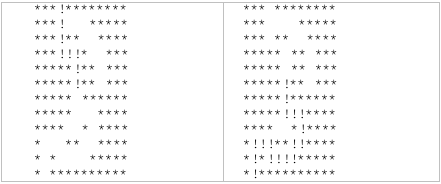import java.io.File;
import java.util.Scanner;
import java.io.IOException;
/**
* Description of the Class
*
* @author Administrator
* @created July 16, 2002
*/
class ThreadTheMaze{
/**
* Description of the Field
*/
private final static char BLANK = ' ';
private static final int MAXROW = 12;
private static final int MAXCOL = 12;
private int myMaxRow;
private int myMaxCol;
private char [][] myMaze;
public ThreadTheMaze(){
myMaze = new char [MAXROW + 1][MAXCOL + 1];
myMaxRow = myMaze.length - 1;
myMaxCol = myMaze[0].length - 1;
}
/**
* Initiates the trace process
*
* @param none
*/
public void doTraceMaze() {
loadMaze();
traceMaze(myMaze, myMaxRow/2, myMaxCol/2);
}
/**
* Loads the maze characters from mazeData.txt
*
* @param maze Description of Parameter
*/
private void loadMaze(){
String line;
Scanner in;
try{
in = new Scanner(new File("mazeData.txt"));
for (int row = 1; row <= myMaxRow; row++){
line = in.nextLine();
for (int col = 1; col <= myMaxCol; col++){
myMaze[row][col] = line.charAt(col-1);
}
}
}catch(IOException i){
System.out.println("Error: " + i.getMessage());
}
}
/**
* Description of the Method
*
* @param maze Description of Parameter
*/
public void printMaze(char[][] maze){
Scanner console = new Scanner(System.in);
for (int row = 1; row <= myMaxRow; row++){
for (int col = 1; col <= myMaxCol; col++){
System.out.print("" + maze[row][col]);
}
System.out.println();
}
System.out.println();
System.out.println("Hit enter to see if there are more solutions.");
String anything = console.nextLine();
}
/**
* Will attempt to find a path out of the maze. A
* path will be marked with the ! marker. The method
* makes a copy of the array each time so that only
* the path out will be marked, otherwise extra !
* markers will appear in the answer.
* The function is recursive.
*
* @param maze Description of Parameter
* @param row Description of Parameter
* @param col Description of Parameter
*/
public void traceMaze(char[][] maze, int row, int col){
//char[][] mazeCopy = (char[][])maze.clone();
char[][] mazeCopy = new char[maze.length][maze[0].length];
for (int r = 0; r < mazeCopy.length; r++){
for (int c = 0; c < mazeCopy[0].length; c++){
mazeCopy[r][c] = maze[r][c];
}
}
if (1 <= row && row <= myMaxRow && 1 <= col && col <= myMaxCol){
// boundary check, if false, a base case
if (BLANK == mazeCopy[row][col]){
// if false, base case
mazeCopy[row][col] = '!';
if (1 == row || myMaxRow == row || 1 == col || myMaxCol == col){
printMaze(mazeCopy); // base case
}else{
traceMaze(mazeCopy, row - 1, col);
traceMaze(mazeCopy, row, col + 1);
traceMaze(mazeCopy, row + 1, col);
traceMaze(mazeCopy, row, col - 1);
}
}
}
}
}
